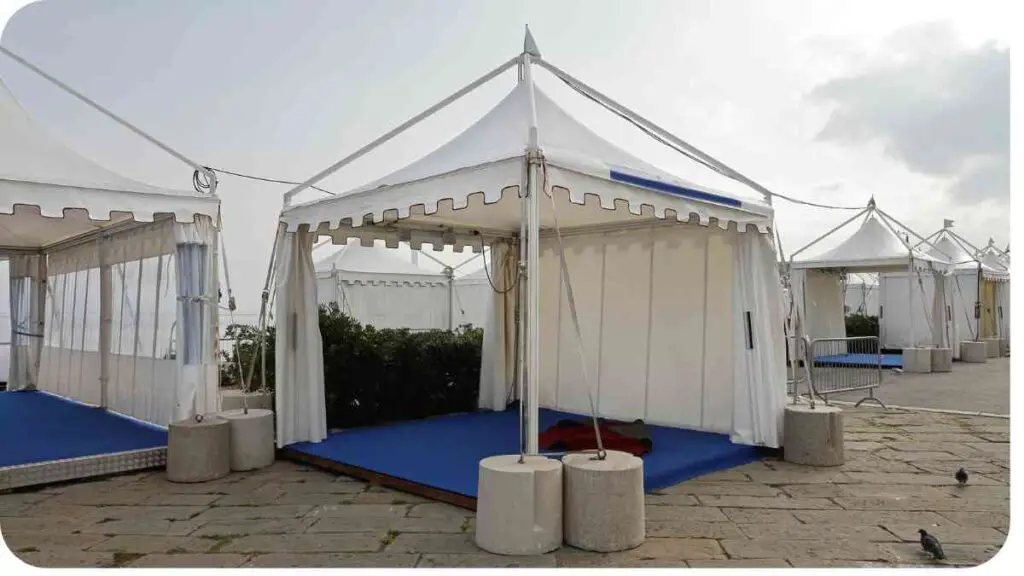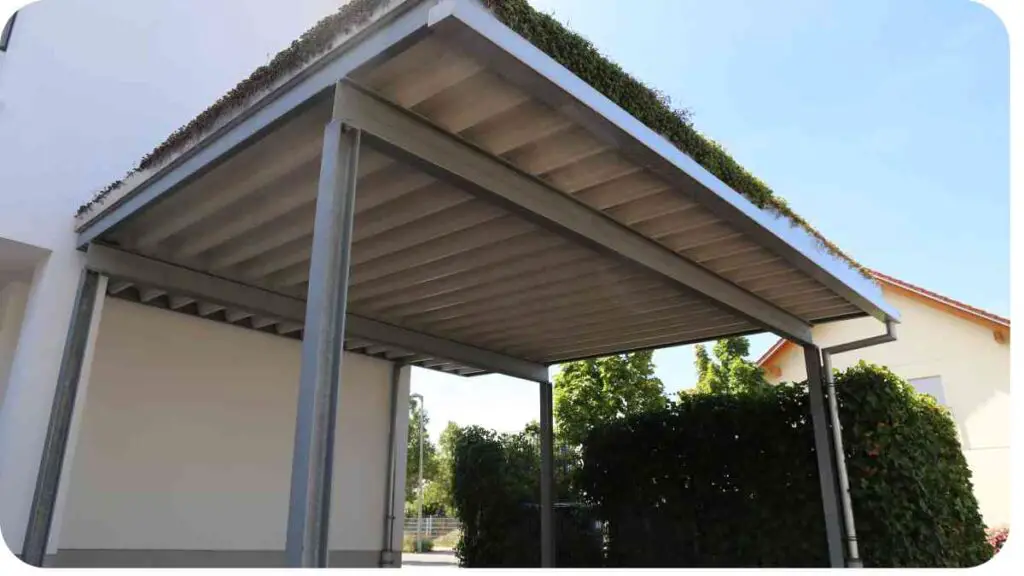Are you planning an outdoor event or camping trip and wondering how to lift a canopy tent effortlessly? You’re in the right place! Lifting a canopy tent may seem daunting, especially if it’s large or heavy.
However, with the right techniques and precautions, you can easily hoist it into position without breaking a sweat. In this guide, we’ll walk you through everything you need to know to lift a canopy tent safely and efficiently.
| Key Takeaways |
|---|
| 1. Choose the right lifting technique based on your canopy tent’s size and weight. |
| 2. Prepare the lifting area by clearing debris and assembling the tent beforehand. |
| 3. Safety should always be a top priority when lifting a canopy tent – use proper lifting techniques and communicate effectively with your team. |
| 4. Avoid common mistakes such as attempting to lift the tent alone or exceeding weight limits. |
| 5. Follow tips for smooth lifting, including practicing the technique and staying hydrated. |
2. Understanding Canopy Tents

Before diving into lifting techniques, let’s briefly understand what canopy tents are. Canopy tents, also known as pop-up tents or portable shelters, are versatile structures commonly used for outdoor events, camping, picnics, and trade shows.
They typically consist of a collapsible frame and a canopy fabric stretched over the frame. Canopy tents come in various sizes, shapes, and designs to suit different purposes and preferences.
When setting up your patio canopy, ensure proper anchoring to withstand weather elements and enhance stability. Securely fasten the canopy to your patio furniture or structure to prevent displacement during windy conditions.” put up a patio canopy
| Type of Canopy Tent | Description |
|---|---|
| Traditional Pole Tents | Classic design with center poles and guy lines for stability. |
| Frame Tents | Modern design featuring a frame structure without center poles, providing more interior space. |
| Pop-Up Canopies | Lightweight and easy to set up, ideal for quick shelter during events or outdoor activities. |
Understanding the type of canopy tent you have will help determine the lifting technique that best suits your tent’s design and weight.
3. Assessing Your Tent’s Weight and Size
The first step in lifting a canopy tent is assessing its weight and size. This information will guide you in choosing the appropriate lifting technique and determining how many people you need to assist you.
Most canopy tents come with specifications regarding weight and dimensions
Refer to your tent’s manual or manufacturer’s website to find this information.
| Canopy Tent Size | Weight (Approx.) | Recommended Lifters |
|---|---|---|
| Small (10’x10′) | 20-40 lbs | 2-3 people |
| Medium (10’x20′) | 40-60 lbs | 3-4 people |
| Large (20’x20′ or larger) | 60+ lbs | 4+ people |
Always err on the side of caution and enlist additional help if you’re unsure about lifting the tent on your own.
4. Preparing for Lifting
Before you start lifting the canopy tent, it’s crucial to prepare both yourself and the tent to ensure a smooth and safe process.
Deck canopies offer a stylish and functional addition to your outdoor space. Follow these steps to safely install a canopy on your deck, providing shade and protection for your gatherings and activities.” canopy on your deck
Cleaning the Area
Clear the area where you plan to set up the tent. Remove any debris, rocks, or obstacles that could interfere with the lifting process or damage the tent.
Assembling the Tent
If your canopy tent requires assembly, follow the manufacturer’s instructions to set it up. Ensure that all parts are properly connected and secured before attempting to lift the tent.
Positioning Lifters
Assign specific roles to each person assisting with the lift. Designate someone to coordinate the lifting process and ensure everyone is positioned correctly. Communicate clearly and establish a plan before lifting the tent.
5. Lifting Techniques
Now that you’ve prepared the tent and gathered your team, it’s time to explore different lifting techniques.
Opening a slant leg canopy requires careful handling to avoid damage and ensure proper functionality. Follow these instructions to safely and efficiently open your canopy, allowing for quick and hassle-free setup.” open a slant leg canopy
Technique 1: Team Lift
The team lift technique involves multiple people lifting the tent simultaneously. Each person grabs hold of a designated handle or section of the tent and lifts it together with the rest of the team. This technique is effective for medium to large-sized tents that require significant lifting force.
Technique 2: Pole Lifting
For traditional pole tents, pole lifting is a common technique used to hoist the tent into position. Position one person at each center pole and lift the tent by raising the poles simultaneously. This technique requires coordination and may be more challenging for larger tents with multiple center poles.
Technique 3: Lever System
The lever system involves using leverage to lift the tent with minimal effort. Place a sturdy object, such as a wooden plank or metal bar, underneath the tent frame. Use the lever to lift the tent gradually, taking care to distribute the weight evenly and avoid strain.
6. Safety Measures

Safety should always be a top priority when lifting a canopy tent. Follow these safety measures to prevent injuries and ensure a successful lift:
- Proper Lifting Technique: Bend your knees and lift with your legs, not your back, to avoid straining your muscles.
- Communicate: Use verbal cues or signals to coordinate the lifting process with your team members.
- Watch for Obstacles: Be mindful of overhead obstacles, uneven terrain, or other hazards that could pose a risk during the lift.
- Take Breaks: If the tent is heavy or the lift is challenging, take regular breaks to rest and prevent fatigue.
Master canopies can be heavy and cumbersome to remove without proper technique. Learn how to safely dismantle and store your master canopy, ensuring longevity and ease of use for future applications.” remove a master canopy
7. Common Mistakes to Avoid
Avoid these common mistakes when lifting a canopy tent:
- Lifting Alone: Attempting to lift a heavy tent alone can lead to injury. Always enlist the help of others.
- Ignoring Weight Limits: Exceeding the weight limit or capacity of the lifting technique can result in accidents or damage to the tent.
- Rushing the Lift: Take your time and ensure everyone is ready before lifting the tent. Rushing the process increases the risk of mistakes or injuries.
8. Tips for Smooth Lifting
Follow these tips to make the lifting process smoother and more efficient:
- Practice: Familiarize yourself with the lifting technique before attempting to lift the tent.
- Use Proper Equipment: If available, use lifting straps or equipment designed for moving heavy objects.
- Stay Hydrated: Drink plenty of water to stay hydrated, especially if lifting the tent outdoors in warm weather.
- Work as a Team: Communicate effectively and work together with your team to lift the tent safely.
Sealing your canopy effectively protects it from moisture and prolongs its lifespan. Follow these steps to properly seal your canopy, safeguarding it against water damage and maintaining its structural integrity over time.” seal a canopy
Conclusion
Lifting a canopy tent doesn’t have to be a daunting task. With the right preparation, technique, and teamwork, you can hoist your tent into position with ease. Remember to assess your tent’s weight, prepare the lifting area, and follow safety measures to ensure a successful lift.
Whether you’re setting up for an outdoor event or embarking on a camping trip, mastering the art of lifting a canopy tent will make the experience smoother and more enjoyable for everyone involved.
Further Reading
- How to Stand Up and Break Down Your Canopy Tent: This article provides detailed instructions on setting up and taking down your canopy tent, ensuring smooth operations during your outdoor events or activities.
- Canopy Lift: Learn about canopy lift systems and how they can simplify the process of lifting heavy canopy tents, making setup easier and more efficient.
- 8 Tips to Help Keep Your Pop-Up Canopy from Blowing Away: Discover useful tips for securing your pop-up canopy and preventing it from blowing away in windy conditions, ensuring your canopy stays put throughout your outdoor adventures.
FAQs
How do I assess the weight of my canopy tent?
To assess the weight of your canopy tent, refer to the specifications provided by the manufacturer. These specifications typically include the weight of the tent, allowing you to determine whether additional assistance is needed for lifting.
What should I do if my canopy tent is too heavy to lift alone?
If your canopy tent is too heavy to lift alone, enlist the help of others to assist with the lifting process. Working together as a team will make lifting heavier tents much easier and safer.
Can I use a lever system to lift my canopy tent?
Yes, a lever system can be used to lift a canopy tent, particularly for heavier tents. By using leverage, you can distribute the weight more evenly and reduce the amount of force required to lift the tent.
How do I prevent my canopy tent from blowing away in windy conditions?
To prevent your canopy tent from blowing away in windy conditions, use anchor weights or stakes to secure the tent to the ground. Additionally, consider using guy lines or tie-down straps for added stability.
Are there any safety precautions I should take when lifting a canopy tent?
Yes, safety should always be a priority when lifting a canopy tent. Use proper lifting techniques, communicate effectively with your team members, and be mindful of potential hazards such as uneven terrain or overhead obstacles.

I am Hellen James, a professional handywoman with expertise in improving home and garden spaces by using pergolas, gazebos, and tents.


